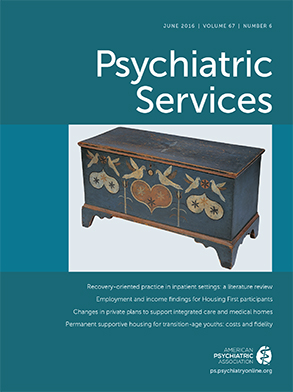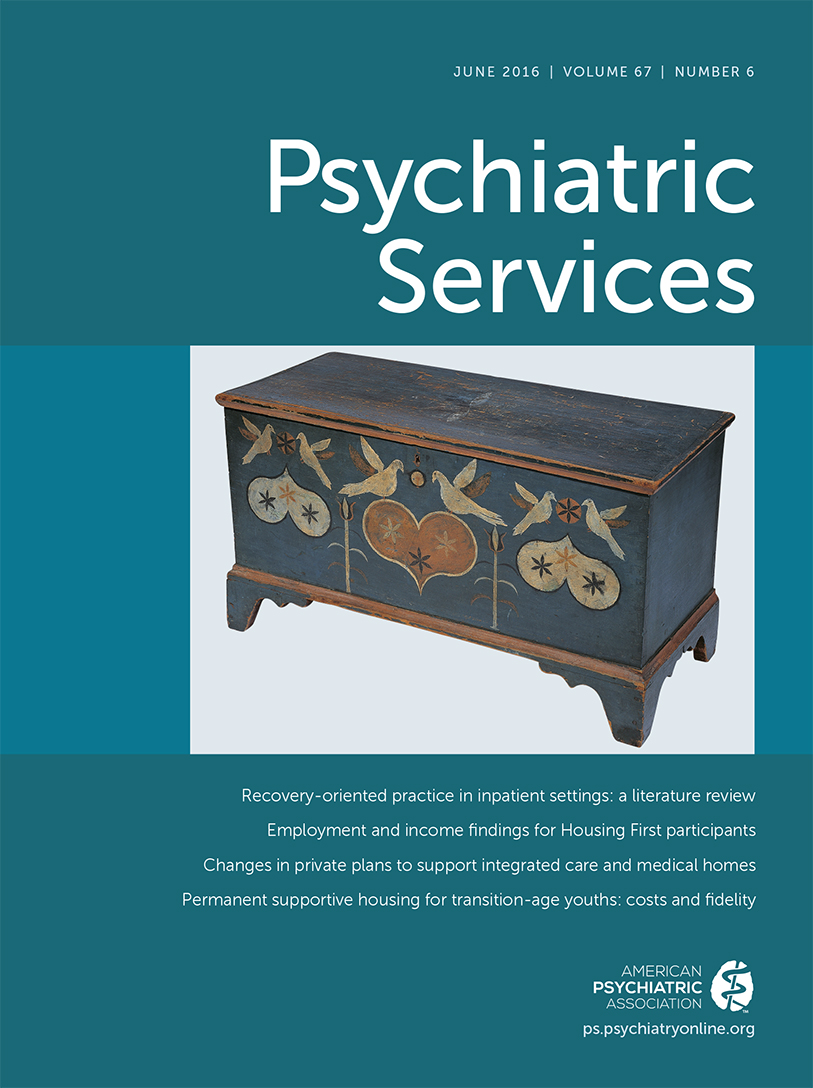Depression affects 12% to 25% of adolescents (
1,
2) and is associated with a range of negative academic, social, and health outcomes (
3–
6). Despite the high burden of depression and the availability of effective treatments, approximately 60% to 80% of affected adolescents do not receive appropriate care (
7–
9). Pediatric primary care is an important site for the identification of depression among adolescents, the critical first step in connecting youths to treatment (
10,
11). However, depression remains poorly identified in this setting (
12–
15). There is consensus among professional organizations and experts in pediatrics and psychiatry to recommend routine screening of adolescents for depression to improve case identification, although available evidence suggests that screening coverage is very low (
16–
18).
Quality measurement is an increasingly prominent approach for improving care, whereby providers and organizations are incentivized to adhere to essential health care practices (
19–
22). The U.S. Preventive Services Task Force (USPSTF) and other major practice guidelines have recommended depression screening in primary care (
12,
15). Screening for depression in primary care has featured prominently in efforts to improve depression care, including national initiatives to develop quality measures (
12,
15). For example, the Centers for Medicare and Medicaid Services (CMS) included depression screening and follow-up for adolescents and adults as a quality measure in its electronic health record (EHR) incentive program, which encourages “meaningful” use of EHRs. Similarly, the National Collaborative for Innovation in Quality Measurement (NCINQ), one of seven centers of excellence funded by the Agency for Healthcare Research and Quality and CMS Pediatric Quality Measures Program, developed a suite of potential quality measures organized around a care pathway for managing adolescent depression in primary care. The first step in the pathway, and the first potential quality measure, is screening for depression (
22).
The objective of this study was to partner with a large health maintenance organization (HMO) to further examine the use of depression screening as a quality measure. In the study, NCINQ partnered with the HMO to study changing patterns of depression screening over time. USPSTF has also specifically highlighted the need for research linking screening to improved identification of depression cases (
16). Therefore, this study also assessed the diagnosis of depression following screening, which NCINQ included as the second potential measure in the care pathway. Examination of large-scale, naturalistic data on screening and diagnosis will help to identify gaps in essential care practices related to identification of depression and provide an indication of the fit and possible value of depression quality measures in the context of current practice.
Discussion
This study assessed changing patterns of adolescent depression screening and diagnosis in a large HMO to inform the development and adjustment of quality measures. These data also make a novel contribution to the scant evidence about screening and depression diagnosis in primary care in general. In line with an organizational recommendation to screen for depression among adolescents, screening at the HMO increased over three years, predominantly in primary care. The increase in screening led to a corresponding increase in depression diagnoses made in primary care and a shift in the location of many diagnoses from the mental health department to primary care. The increase in screening also led to a decrease in the proportion of positive screening results that resulted in depression diagnoses.
We speculate that the increase in screening occurred predominantly in primary care because although the HMO recommended screening of adolescents for depression organizationwide, the emphasis of the recommendation was on pediatric primary care. The recommendation was also less likely to have an impact on the mental health department, where providers were already in the practice of using the PHQ-9 for symptom identification and diagnostic support, most likely in the context of a depression complaint.
The finding that increased depression screening in primary care led to increased depression diagnosis in primary care, while intuitive, has little prior empirical support. Reflecting the lack of such evidence, the USPSTF has advocated precisely for research linking increased depression screening of adolescents with increased case identification (
17). One large cross-sectional study of mental health screening of adolescents estimated national depression screening rates but did not provide data on results of the screening or on depression diagnoses made subsequent to the screening (
18). This study also relied on provider self-report of screening practices rather than a review of the EHRs, as was the case in this study.
Another large study, which was based on Massachusetts Medicaid claims data, found that a state mandate and incentive to conduct behavioral health screening with children in primary care led to large increases in administered screens over a one-year period and an increase in behavioral health assessments over the same period, although it was not possible to link these changes given that they came from different data sets (
26). Depression screening in the Massachusetts study employed the PHQ-9 but only among older adolescents (ages 18 to 20), a much narrower age range compared with the age range in this study (ages 12 to 21). This study is the first published report of which we are aware to present naturalistic data on a large-scale implementation of adolescent depression screening in primary care and the first to link changes in screening practices over time to changes in frequency of depression diagnoses.
We also aimed to gauge the possible fit and utility of quality measures outlined in the NCINQ depression care pathway in a real-world practice setting, given current patterns in depression case identification and management. We speculate from the findings that the first two measures in the care pathway (screening and diagnostic assessment) are well situated to facilitate important changes in care and to contribute to improved identification of depression. This study provides encouraging evidence of providers’ willingness to adopt screening on the basis of organizational recommendations. This, again, is an intuitive—yet important—finding, in light of studies demonstrating challenges in screening uptake and adoption (
26,
27).
Nevertheless, despite the dramatic increase in the rate of screening from 2010 to 2012, coverage remained at only 11% of the adolescent population by 2012. The Massachusetts Medicaid claims study, which reported a screening rate of 50% after providers were incentivized to adhere to state-mandated practices, suggests that greater increases in screening may be obtained with an official mandate and incentive, such as a quality measure for screening.
We also speculate that a quality measure to mandate timely follow-up after a positive screening result could further improve case identification. In this study, the increase in depression screening in primary care resulted in a decrease in the proportion of incident positive PHQ-9s that led to confirmed depression diagnoses. We suggest some hypotheses to account for this result. Given the positive predictive value of the PHQ-9 for adolescents in primary care (15.2%) (
24), it is likely that many positive results from PHQ-9 screening simply were not true cases of depression, possibly representing transient mood symptoms, and primary care providers were correct in not making depression diagnoses. However, increased use of the PHQ-9 as a screening tool in primary care may also lead to more frequent identification of consistent mild symptoms that are more difficult to diagnose confidently as depression. Considering that pediatricians may not feel confident in their ability to diagnose depression (
27), the lack of diagnosis following positive PHQ-9 results may reflect difficulty or reluctance to make a diagnosis when one is warranted.
It is also possible that incident positive PHQ-9 results that did not lead to confirmed depression diagnoses represented true-positive cases of depression that did not receive a follow-up assessment to confirm the diagnosis. The possibility that case identification in primary care may be impeded by reluctance or low diagnostic confidence among primary care providers or by bottlenecks or barriers to further assessment highlights the need, as USPSTF recommends, to establish systems for accessing mental health supports to ensure accurate diagnosis and appropriate follow-up before initiating screening. A quality measure mandating and incentivizing the essential practice of confirming a depression diagnosis within a specified time after a positive screen could serve to facilitate changes to provider behavior and to organizational structure or work flow to ensure that these supports are available and accessed.
The HMO that served as a partner in this study is an example of a health system that has taken steps to meet the growing need to make mental health supports accessible in primary care. Many practices and organizations will not have the ability to provide such support internally and may instead partner with other organizations to establish the necessary mental health assessment and referral support. Other important challenges with screening, such as increasing the acceptability of screening to families and training providers in administration, scoring, and postscreening clinical decision making, must be addressed to ensure optimal functioning of screening initiatives (
28). Further discussion of these factors is beyond the scope of this article.
This study had several limitations. Because data were aggregated and anonymous, it was not possible to ascertain PHQ-9 results and depression diagnoses for individual adolescents after the initial clinical visit. Future efforts should track individual patients through this process and beyond to assess additional factors associated with care quality, including whether a referral was made to specialty mental health services, whether psychotherapy was provided, and whether an antidepressant was ordered.
Because this study was conducted in a single setting, it is possible that the demonstrated impact of increased depression screening may not generalize to other practice settings with different clinical work flows and different administrative or organizational structures or policies. We speculate, nevertheless, that increased screening in primary care will lead to increases in identification of depression symptoms in other primary care settings. There may be, however, differences between settings in how these newly identified symptoms translate into depression diagnoses because of differences in provider training and experience, clinical work flow and resources, and organizational structure and policies. Each organization that implements screening is likely to face unique changes in clinical work flow and challenges in ensuring appropriate follow-up for youths who screen positive for depression.

